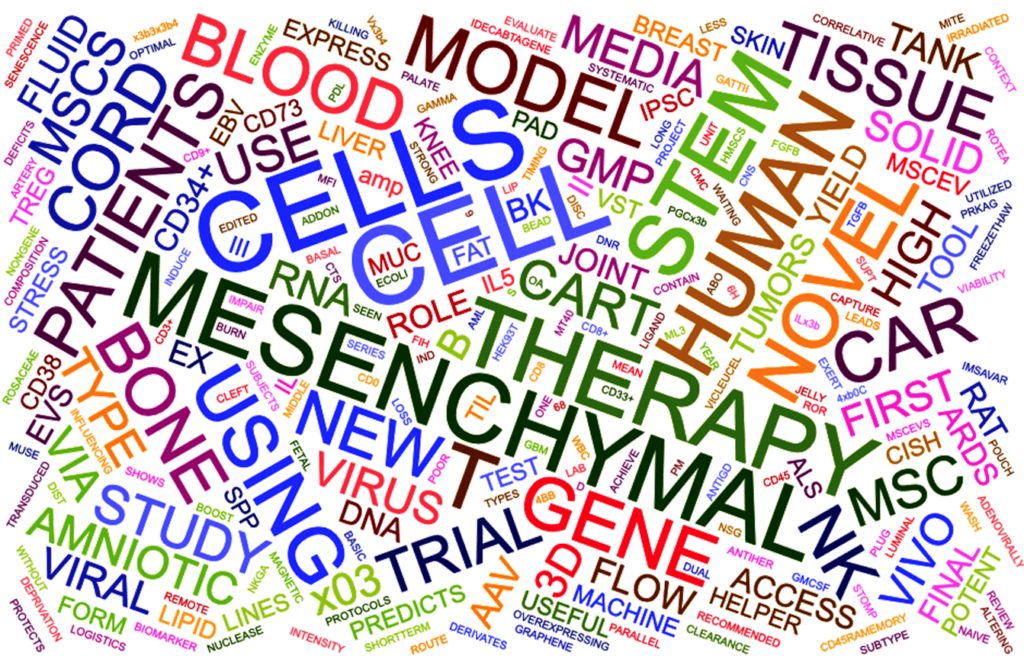
IMAGE SOURCE: via craiyon.com; QUERY: “Generate a hi-rest postcard image that combines the city skylines of Paris, Seattle, and Los Angeles”
We asked a popular AI image generator, Craiyon, to assist us with festive postcard art to accompany this blog about RoosterBio’s upcoming May conferences (above). The results? Droll but vaguely dystopic, as if glimpsed from a parallel universe turned slightly off-kilter. Perhaps it’s just as well that three great cities (Paris, Los Angeles, Seattle) remain true to their unique history and culture as they welcome RoosterBio and thousands of other international visitors to ISCT (International Society for Cell & Gene Therapy, 31-May to 3-June, Paris), ASGCT (American Society for Gene and Cell Therapy, 16-20 May, Los Angeles), and ISEV (International Society for Extracellular Vesicles, 17-21 May, Seattle).
Although these destinations are each quite different, their 2023 selection for conferences that report from advanced therapies’ leading edge is no accident. Paris hosts the world-class Pasteur Institute, the Curie Institute, and INSERM, and is a “City of Light” that illuminates the way toward collaborative research and breakthroughs in cell therapy. Los Angeles, home of UCLA, CalTech, and City of Hope is a bustling and diverse hothouse of new technology and innovation. Seattle, the Emerald City, is “evergreen” for an interdisciplinary and entrepreneurial spirit that leverages high-powered computation into nano-scale engineering and personalized medicine via institutions like the Hutch and the U of Washington School of Medicine.
ISCT’s mission is to advance the field of cell and gene therapy through education, scientific exchange, and advocacy; its Paris annual meeting will draw >1500 attendees from dozens of countries. LA’s ASGCT hosts a meeting that attracts almost 8000 to foster the development and application of cell and gene therapies to treat and cure genetic and acquired diseases. ISEV will greet over 1000 delegates with extracellular vesicle (EV) focus to promote scientific cross-pollination on the roles of EVs/exosomes in health and disease; in this year’s Seattle meeting, there will likely be a continued acceleration into topics pertaining to clinical translation of different EV subtypes.
With RoosterBio in center field of this exciting era of cellular therapeutics with engineered genes, cells, and EVs, we’re deeply honored to present our latest work by way of six abstracts on process development of extracellular vesicles (EVs)/exosomes and gene delivery into primary cells like hMSCs. We’re especially thrilled that four of these posters are the result of ongoing and fruitful collaborative efforts with Sartorius, Repligen, and Mirus. Also, we and the Southwest Research Institute (SwRI®) jointly contribute authors to one poster as a result of a contracted engagement under a grant from the Medical Technology Enterprise Consortium (MTEC). Together these abstracts address different challenges facing scaled-up bioproduction of clinical grade EVs, or with GMP-friendly scale-up of mRNA transfection of hMSCs.
Successful Development of a Scalable & Robust Process for MSC-EV Production
Authors: Stephen Lenzini,1 Jae Jung,1 Grishma Patel,2 Sanket Jadhav,2 Priyanka Gupta,2 Rukmini Ladi,2 Michael Boychyn,1 Elie Zakhem,1 Jon Rowley.2 Presented at ISEV and ISCT.
1 RoosterBio Inc, 5295 Westview Drive, Suite 275, Frederick, MD 21703. 2 Sartorius Stedim North America Inc, 565 Johnson Avenue, Bohemia, NY, 11716
Development of an End-to-End Scalable Purification Platform for Extracellular Vesicles
Authors: Grishma Patel,1 Sanket Jadhav,1 Priyanka Gupta,1 Mehdi (Aslan) Dehghani,1 Simon Staubach,1 Betlihem Teshome,1 Jae Jung,2 Stephen Lenzini,2 Cameron Garland,2 Michael Boychyn,2 Jon Rowley,2 Elie Zakhem.2 Presented at ISEV and ISCT.
1 Sartorius Stedim North America Inc, 565 Johnson Avenue, Bohemia, NY, 11716. 2 RoosterBio Inc, 5295 Westview Drive, Suite 275, Frederick, MD 21703
Development of Manufacturing Therapeutic Platform for Extracellular Vesicles Derived from Mesenchymal Stromal Cell (MSC-EVs) Using Scalable Manufacturing Clarification & Concentration Diafiltration System platforms, The Tangential Flow Depth Filtration (TFDF) & the Tangential Flow Filtration (TFF) with Hollow Fibers
Authors: Elie Zakhem1, Jae Jung1, Cameron Garland1, Michael Boychyn1, Lauren Torres2, Mario Sinani2, Carl Breuning2, Jeremy Neidert2, Rachel Legmann.2 Presented at ISCT.
1 RoosterBio, Inc. 5295 Westview Drive, Frederick, MD 21703. 2 Repligen Corp. 41 Seyon St. Waltham, MA, 02453
Biomanufacturing of Extracellular Vesicles from Mesenchymal Stromal Cells Grown in a Novel Perfusion-based & Alternative Bioreactors
Authors: Jae Jung1, Robert Kirian1, Theresa D’Souza1 Jian Ling2, Nicholas McMahon2, Kreg Zimmern2, Jon Rowley1. Presented at ISEV.
1 RoosterBio Inc, 5295 Westview Drive, Suite 275, Frederick, MD 21703. 2 Southwest Research Institute (SwRI®), 6220 Culebra Road, San Antonio, Texas 78228
AAV Transduction of MSCs is Enhanced by Genetic Engineering Medium
Authors: Mary Doolin, Terri Willstaedt, Michael Boychyn, Jon Rowley. Presented at ASGCT, Poster #453, 17-May, 12pm.
A GMP-Compatible Process for the Efficient Transfection of MSCs with mRNA
Authors: Terri Willstaedt, Mary Doolin, Michael Boychyn, Jon Rowley Presented at ASGCT and ISCT (Poster #1235).
One abstract, “Successful development of a scalable and robust process for MSC-EV production,” showcases an ongoing collaboration with Sartorius to use the 15L Biostat STR® Bioreactor to produce EVs via human bone marrow MSCs cultured on Synthemax II microcarriers. MSC-EVs maintained the relevant CQAs from the 250mL scale to the 15L scale. Yields from this optimized “upstream” process reached over 1×1010 particles/mL by day of collection, which after downstream processing can be considered in the working range of a clinically meaningful lot size (See Establishing a Working Range for Effective MSC-EV Dose). This title will be shown as a poster by Elie Zakhem, Ph.D. at ISEV, and also as an oral presentation by Stephen Lenzini, Ph.D., at ISCT.
“This work demonstrates scalable production of MSC-EVs featuring a microcarrier-based stirred tank process developed at the 250mL scale and validated at the 15L scale.” – Stephen Lenzini, Ph.D., Process Development Scientist
Our next poster, “Development of an end-to-end scalable purification platform for extracellular vesicles,” unifies both upstream and downstream process development via our ongoing Sartorius collaboration. It will be exhibited at both ISEV and ISCT. This work’s aim was to use scalable platform componentry and modules for a 15L end-to-end run that could expand for incorporation of even higher volumes of hMSC culture. This work optimizes Sartorius’ efficient integrated downstream process technologies (i.e., “DSP;” crossflow filtration units for clarification, enzymatic treatments, CIM® monolith chromatography columns), as well as novel analytical methods to test the quality of the EVs. Together, both Sartorius collaboration presentations highlight our pioneering thought co-leadership to advance therapeutic EVs/exosomes.
“The results obtained from this study are very promising and will serve as a baseline for developing a scalable and reproducible EV production process while maintaining EV critical quality attributes.” – Elie Zakhem, Ph.D., Senior Manager, Process Development
Our poster, “Development of Manufacturing Therapeutic Platform for Extracellular Vesicles Derived from Mesenchymal Stromal Cell (MSC-EVs) Using Scalable Manufacturing Clarification and Concentration Diafiltration System platforms, The Tangential Flow Depth Filtration (TFDF) and the Tangential Flow Filtration (TFF) with Hollow Fibers,” emphasizes practical “downstream” process for EV purification and is to be shown at ISCT. Resulting from our collaboration with Repligen instruments and expertise, RoosterBio showed high (95%) recovery yield from a 2L scale microcarrier-based bioreactor process, where cell supernatants were clarified with a TFDF system, and then concentrated and buffer exchanged using TFF.
“This study demonstrates that integrating scalable single-use closed system platforms and consumables early in the downstream processing steps simplified and de-risked the EV manufacturing process at large scale with a high EV recovery while maintaining EV identity and potency” – Elie Zakhem, PhD, Senior Manager, Process Development
“Biomanufacturing of Extracellular Vesicles from Mesenchymal Stromal Cells Grown in a Novel Perfusion-based and Alternative Bioreactors,” presented on a poster at ISEV, will highlight bioprocess from SwRI’s novel, 3D-printed, microcarrier-free perfusion bioreactors that yield high-efficiency EV production from hMSCs grown at very high density. These results are presented alongside new cell expansion data derived from experiments via a microcarrier system with the PBS Biotech Vertical-Wheel® bioreactor. This effort was funded under MTEC solicitation MTEC-19-07-Biomfg and is funded by the USAMRDC under the Department of Defense.*
“We are always searching for novel devices for expanding MSCs to high densities for efficient exosome production that maintains expected critical quality attributes. We believe that perfusion bioreactors may get us to new levels of productivity.” – Jon Rowley, Ph.D., Founder of RoosterBio and Chief Product Officer
As presently applied, Adeno-Associated Virus (AAV) is mostly an in vivo platform for human gene therapies. Nevertheless, AAV’s validated clinical role in FDA-approved gene therapies and its powerful genome editing enabling features (i.e., an ssDNA template strand for homologous recombination) could make it attractive for ex vivo genetic engineered cell therapies. “AAV Transduction of MSCs is Enhanced by Genetic Engineering Medium” is to be shown at ASGCT and demonstrates improvements in AAV gene transfer efficiency into primary cells via RoosterGEM™, our complete genetic engineering medium. In this poster, we also validate which serotypes are most practical use in concert with RoosterGEM for maximum effect.
“We are excited for this poster to show the optimal AAV serotypes for RoosterBio MSCs, as well as how RoosterGEM can aid transduction efficiency. Facilitating the use of less AAV material will reduce costs for our customers and enable more breakthrough research.” – Mary Doolin, Ph.D., Scientist II
Last, but not least, is “A GMP-Compatible Process for the Efficient Transfection of MSCs with mRNA.” This is to be displayed at both ASGCT and ISCT and showcases collaborative work with Mirus™ Here, we demonstrate a practical, scalable, and GMP-compatible procedure to transiently transfect hMSCs with mRNA in concert with Mirus’s™ TransIT-VirusGEN ® reagent. With these methods, difficult-to-transfect hMSCs can attain greater than 80% expression of the reporter gene.
“In combination with gene delivery reagents from Mirus, we’ve developed a method using RoosterGEM that transfects MSCs with mRNA extremely efficiently. The new process is GMP-compatible and fits in seamlessly with our existing processes.” – Mary Doolin, Ph.D., Scientist II

Figure 1, a word cloud based on titles from ISCT-2022’s Annual Meeting abstracts. (IMAGE SOURCE: https://jasondavies.com/wordcloud)
Three cities, three big events, one month! RoosterBio is eager to share its new knowledge—but more importantly—gather feedback on the scientific, applied, and translational needs of our present and future customers and partners. Asked about what Paris, Los Angeles, and Seattle have in common, we asked the ever-enigmatic ChatGPT its opinion. The AI chatbot concluded its remarks with “…all three cities are also known for their traffic congestion…” Although one hopes the traffic won’t be too bad, there will be a similarly lively cacophony of ideas, words, and data for everyone to make sense of on return from ISCT, ASGCT, and ISEV (see Figure 1). RoosterBio will be doing likewise in the coming months. This is instrumental to our core purpose—to simplify navigation of the complex process development and regulatory landscape that lies between regenerative medicine’s benchtop breakthroughs and advanced therapeutic cures.
*Acknowledgement: The work with SwRI was funded under MTEC solicitation MTEC-19-07-Biomfg and is funded by the USAMRDC under the Department of Defense. The views and conclusions contained herein are those of the authors and should not be interpreted as necessarily representing the official policies or endorsements, either expressed or implied, of the U.S. Government.
